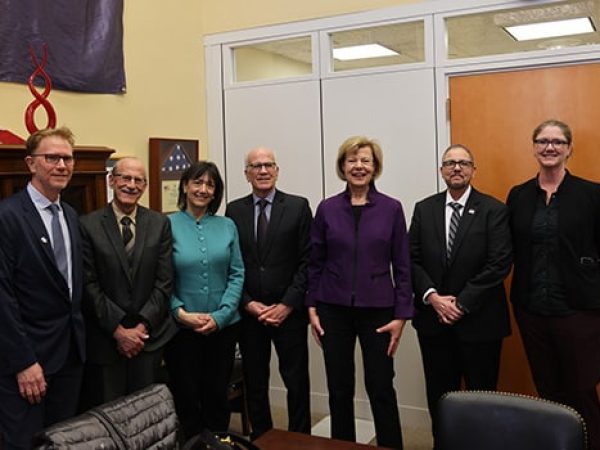From the Journals: Editors’ Picks for July
Each month, the American Association for Cancer Research (AACR) publishes 10 articles from its eight esteemed scientific journals, showcasing some of the leading discoveries in cancer research. Read on to learn about the editors’ selections from this month. All articles featured are freely available for a limited time.
Journal: Clinical Cancer Research (July 1 issue)
The authors evaluated the efficacy of photodynamic therapy (PDT) with or without topical 5-fluorouracil (F5U) pretreatment in patients with actinic keratoses, precancerous lesions that can progress to squamous cell carcinoma of the skin. In a pilot clinical trial, patients received 5FU pretreatment on one side of the body while the other side served as control. In concordance with preclinical studies using mice, pretreatment with 5FU increased the relative clearance rate of the lesions. Pretreatment with 5FU increased the production of protoporphyrin IX (the active photosensitizer) and proapoptotic p53 expression and upregulated the enzymes in the heme synthesis pathway, compared with control lesions. The researchers note that since both PDT and 5FU are approved by the U.S. Food and Drug Administration for the treatment of actinic keratosis, clinicians can readily utilize this combinatorial regimen for their patients.
 Journal: Molecular Cancer Research
Journal: Molecular Cancer Research
Genome Sequencing and RNA-Motif Analysis Reveal Novel Damaging Noncoding Mutations in Human Tumors
To improve our understanding of the biological and clinical significance of somatic mutations on RNA processing in cancer, the authors developed a new method, known as MIRA (mutation identification for RNA alterations). The method enables a comprehensive evaluation of significantly mutated areas in both coding and noncoding regions of DNA that affect the sites for RNA-binding proteins. In conjunction with RNA sequencing data, the researchers used MIRA to identify mutations in binding sites that altered RNA expression and splicing. This analysis revealed previously unidentified alterations in untranslated regions, long noncoding RNAs, and introns that may guide the interpretation of noncoding variants in cancer genomes.
Journal: Cancer Immunology Research
The authors sought to investigate the function of interleukin 22 (IL22) in lung oncogenesis, and found that higher expression of the interleukin receptor IL22R1 was associated with lower recurrence-free survival in patients with KRAS-mutant lung adenocarcinoma. Following the genetic ablation of IL22 in a mouse model of KRAS-mutant lung cancer, the number and size of tumors was significantly reduced compared to mice with functional IL22. Furthermore, loss of IL22 reduced the number of lung-infiltrating inflammatory cells and decreased the expression of protumor inflammatory cytokines, while also increasing the antitumor Th1 and cytotoxic T-cell responses. Based on these results, the authors suggest that pharmacologic targeting of IL22 in combination with chemotherapy, checkpoint inhibition, or other targeted therapies may benefit patients with KRAS-mutant lung cancer.
Journal: Molecular Cancer Therapeutics
The authors analyzed the next-generation sequencing (NGS) data from 216 patients with advanced thyroid carcinoma. Mutations were found in over 70 percent of carcinomas, predominantly in the therapeutically targetable MAPK pathway (68 percent) and a few in the PI3K/AKT pathway (4 percent). NGS analysis with advanced papillary thyroid carcinomas revealed that the frequency of secondary mutations in PIK3CA, which may confer resistance to single-agent targeted therapy, were eight times more than that of The Cancer Genome Atlas Research Network study with primary well-differentiated papillary thyroid carcinoma. This retrospective analysis revealed that patients with poorly differentiated thyroid carcinoma who received targeted therapeutics against activating mutations had improved survival compared with those whose tumors did not have mutations in targetable pathways. The authors therefore advocate for NGS testing in patients with advanced thyroid carcinomas to enable the identification of MAPK aberrations and the co-mutations associated with resistance, such as those in PI3K/AKT, which is valuable to guide the selection of targeted therapies.
Journal: Cancer Research (July 15 issue)
The authors established the first molecular subtype-specific, human-relevant mouse model of luminal-like (UPPL) bladder cancer and evaluated its response to immunotherapy as compared to a model of basal-like (BBN) bladder cancer. The UPPL model had decreased immune infiltration and displayed a decreased response to PD-1 inhibition relative to the BBN model. Furthermore, BBN tumors that were responsive to checkpoint inhibition demonstrated alterations in the composition of the immune microenvironment relative to non-responsive BBN tumors. Both UPPL and BBN models expressed targetable immunogenic neoantigens, highlighting their utility in the evaluation of immunotherapy efficacy in bladder cancer.
Journal: Cancer Research (July 1 issue)
Chimeric antigen receptor (CAR) T-cell therapy, which is highly effective against certain blood cancers, has not been efficacious in solid tumors for several reasons, including the immunosuppressive microenvironment. In this study, the authors evaluated the use of targeted lipid nanoparticles loaded with immune-modulatory agents as a pretreatment for CAR T-cell therapy in mice with solid tumors. The nanocarriers contained two immunomodulating agents, a selective inhibitor of PI3 kinase that is active against a subset of regulatory T cells, and an immunostimulant-invariant natural killer T-cell agonist. Infusion of the targeted nanocarriers in mice bearing breast cancer yielded a two-week therapeutic window during which the CAR-T cells eliminated tumors in half of the mice. This pretreatment could facilitate the use of CAR T-cell therapy in patients with solid tumors.
Journal: Cancer Epidemiology, Biomarkers & Prevention
Parents’ Views on the Best and Worst Reasons for Guideline-Consistent HPV Vaccination
Utilizing data from The Adolescent Cancer Prevention Communication Study, the authors developed a best-worse scale to evaluate 11 commonly used reasons that health care providers give to parents to encourage human papillomavirus (HPV) vaccination. About 1,200 parents of adolescents completed an online survey to indicate what they thought were the best and worst reasons for vaccinating their children. Parents viewed the best rationale for HPV vaccination to be cancer prevention; other positive reasons included preventing a common infection, having lasting benefits, or being a safe vaccine. Conversely, parents viewed the following messages as the worst rationale for HPV vaccination: it is a scientific breakthrough, I got it for my own child, and your child is due. The authors recommend that health care providers emphasize cancer prevention when discussing HPV vaccination, a message that is also promoted by various public health and professional organizations, including the American Academy of Pediatrics.
Journal: Cancer Discovery
STK11/LKB1 Mutations and PD-1 Inhibitor Resistance in KRAS-Mutant Lung Adenocarcinoma
In this study, the authors evaluated the efficacy of PD-1 inhibitors in patients with KRAS-mutant lung adenocarcinoma with or without concurrent mutations in STK11/LKB1 or TP53. Treatment with PD-1 blockade resulted in an objective response rate of 7.4 percent, 28.6 percent, and 35.7 percent in patients with concurrent KRAS and STK11/LKB1 mutations, KRAS only mutations, or concurrent KRAS and TP53 mutations, respectively. Furthermore, in KRAS-mutant mouse models of lung adenocarcinoma, loss of STK11/LKB1 promoted resistance to PD-1/PD-L1 inhibitors, suggesting that these alterations may have a causal role. This study establishes mutations in STK11/LKB1 as a major genomic driver of PD-1 inhibitor resistance in KRAS-mutant lung adenocarcinoma.
Journal: Clinical Cancer Research (July 15 issue)
To identify the mechanisms that mediate resistance to immunotherapy in melanoma, the authors analyzed a kinome library to study the overexpression of certain genes that can help melanoma cells avoid elimination by tumor-infiltrating lymphocytes (TILs). The screen identified the RNA-binding protein MEX3B, a translational regulator, as a candidate driver of resistance to PD-1 inhibition through its downregulation of HLA-A expression on the surface of tumor cells, thereby shielding them from recognition by T cells. Furthermore, analysis of The Cancer Genome Atlas (TCGA) melanoma database indicated that increased expression of MEX3B is associated with lower cytolytic activity and reduced lymphocyte infiltration in the tumors. These findings may lead to the development of therapeutic strategies targeting MEX3B to overcome resistance to anti-PD1 immunotherapy in patients with melanoma.
Journal: Cancer Prevention Research
Ultraviolent radiation (UVR) from increased ambient sun light exposure has been postulated to lower the incidence and mortality of several cancers. One hypothesis for this premise is that UVR exposure increases vitamin D3 production, which has been proposed to confer anticancer effects. In this study, the authors found that UVR treatment in a breast cancer mouse model delayed the development of tumors, yet neither topical nor dietary D3 affected mammary carcinogenesis. Moreover, the inhibitory effects provided by UVR treatment were independent of circulating levels of vitamin D3. The authors therefore propose that supplemental vitamin D3 may not simulate all of the possible benefits of UVR exposure.



